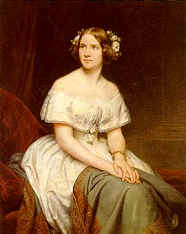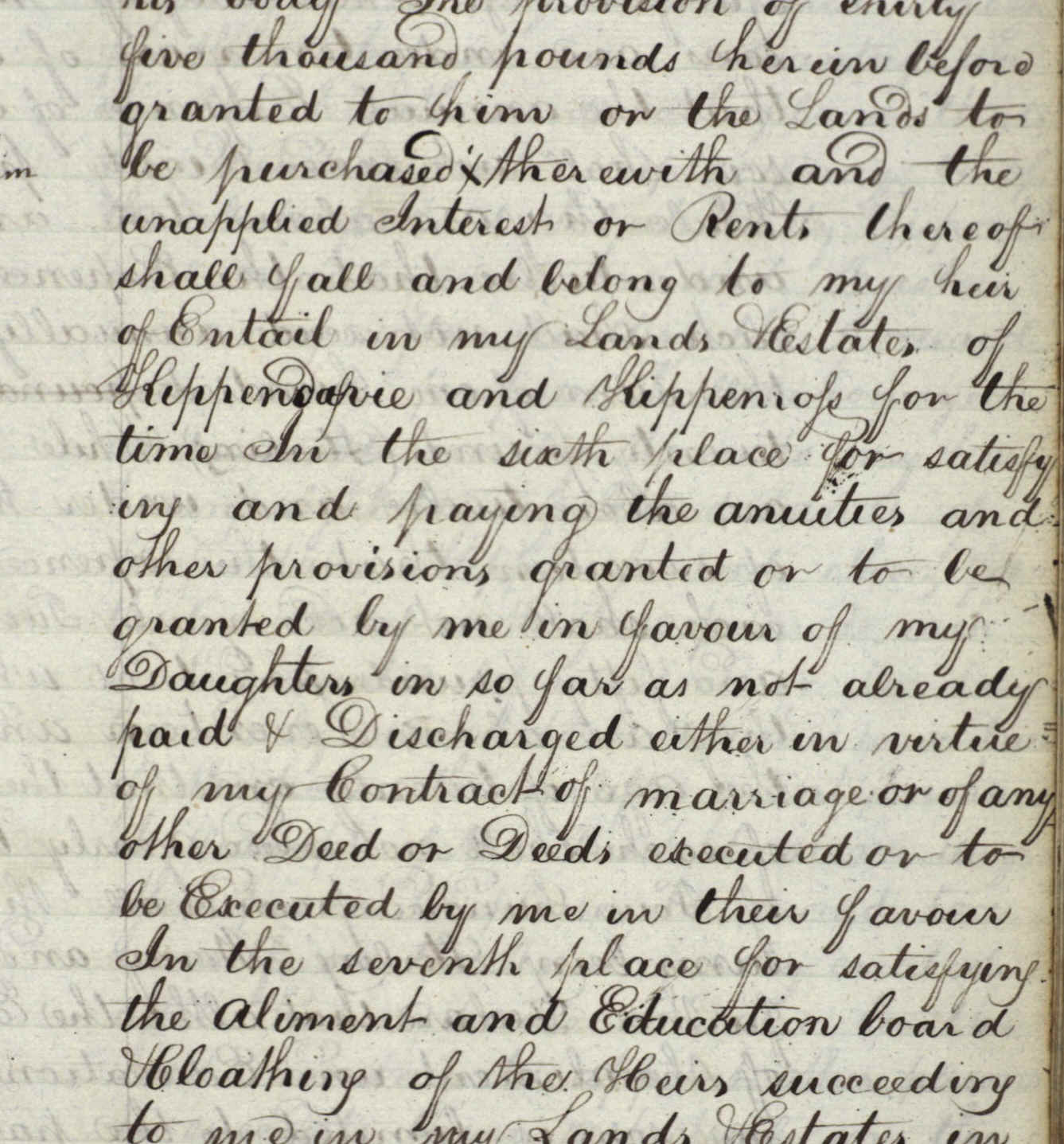Version française du 7 juin 2010
| New research updated 9 March 2013
Regarding the rumours in October 1848
about Chopin
getting
married, the "unmarried one" was obviously
Jenny Lind, soprano and philanthropist - not
Chopin's
former
pupil the Scottish spinster Jane Stirling.
Frederick Niecks, James Huneker, E.L. Voynich, Martial Douël, B.E. Sydow
and Arthur Hedley
fabricated in
1888-1962 an after-construction to embellish
Jane Stirling's
acquaintance
with Chopin.
Later publications by Tad Szulc,
Marie-Paule
Rambeau
and other writers are also inaccurate on 1841-1849.
It is a finding of
Icons of
Europe's research
in 2003-2013, which confirms
the initial conclusion of
Chopin andThe Swedish Nightingale (2003). |
Briefly, the newly re-established facts:
 Jenny Lind
(1820-1887), the celebrated soprano and wealthy
philanthropist, meets Chopin
many times in London in May-July 1848 as documented by his
upbeat letters. She tells exited a friend on 4 September that she is
discussing
a project
with “one of Mendelssohn’s most intimate friends”. Jenny Lind
(1820-1887), the celebrated soprano and wealthy
philanthropist, meets Chopin
many times in London in May-July 1848 as documented by his
upbeat letters. She tells exited a friend on 4 September that she is
discussing
a project
with “one of Mendelssohn’s most intimate friends”.
Jenny Lind obtains a blank marriage allegation form stamped "London
28.9.48" and meets again with Chopin in Edinburgh. Her letters and
1891 Memoir confirm the exit of her Swedish
fiancé "G" by early October
1848. Alone, Chopin walks the corridors of Calder House "with
my doubts" (16 October).
In Chopin’s
letter of 30 October 1848 to Wojciech Grzymala, Jenny.Lind
fits the description of the unmarried
“rich” woman, who is “too much like me”, and who should
rather marry a “young and handsome” man. Chopin seems to refer to a young woman who can “sing”, as he
ponders what happened to his "heart" and "strength".
Jane Stirling (1804-1859), the Scottish
spinster and Calvinist guarded by her elder sister Katherine
Erskine (a widow since 1816), does not
match Chopin’s above description of the “unmarried one”.
She was not rich and young; nor could a "young and handsome"
man have found her attractive. Living on ca. £ 300 p.a,
she could not have
afforded to assist Chopin financially (e.g. 25,000 frs
in July 1849, which beyond any doubt was an anonymous gift from Jenny Lind).
Evidence includes the will of 1816 of Jane
Stirling's father* and her own will of 1859, her docile letters
from 1850-1851, and her death certificate.
A.E. Bone
(p. 100) cites Jane Stirling as “a
hoarse-voiced, restless, invalid Scotch lady of some rank,
mostly wandering about on the Continent” (quoting
Thomas Carlyle
in 1850).¹ Chopin wrote often about how "boring" he
found the two Calvinist sisters.**
Previously manipulated and embellished:
No evidence exists to suggest a romantic relationship
between
Jane Stirling and Chopin. Jane Stirling's acquaintance with Chopin in 1848-1849 has been
distorted or embellished by certain writers.
– Notably: In 1888 by
Frederick Niecks citing rumours
from 1844 and hearsay from 1848;² in 1900 by
James Huneker
(downplaying Jenny Lind, citing Niecks on Jane Stirling); in 1931 by
E.L. Voynich, the strange translator of Chopin's Letters,
who placed a
misleading footnote; in 1932 by
Martial Douël
making, in a respected journal, the baseless if not
preposterous claim of Jane Stirling being “in the lead” of “all of English
high-society”;³ and by
Bronislaw Edward Sydow (1953),
A.E. Bone (1960) and
Arthur Hedley (1962) publishing incorrect and misleading
translations of Chopin's letter of 30 October
1848.***
Arthur
Hedley, a noted English scholar and Chopin expert, goes even
further to embellish Jane Stirling's acquaintance with
unfounded statements in his 1947 biography of Chopin (p.
112). For example, Hedley misuses an out-of-context and erroneous
quotation of
Jane Welsh
Carlyle's letter of 4 August 1850 to raise the notion of
'Chopin's widow dressed in deepest morning'.¹ A.E. Bone
duplicated this feint in 1960 (p. 61).
Evidence points to Jenny Lind as the prime source for
initiating an Orphic / mythological movement in tribute to
Chopin in the 1850s, which involved his friends (Clésinger, Kwiatkowski,
Delacroix, Liszt, Berlioz, Viardot). Grossly
exaggerating, Arthur
Hedley postulates that Jane Stirling "devoted herself
to the cult of his memory".¹
This after-construction
is reflected later in publications by other writers (e.g.
Tad Szulc, Chopin in Paris,
1998;
Marie-Paule Rambeau, Chopin: L'enchanteur
autoritaire, 2005;ª
John Rink and Jim Samson, Chopin Studies 2, Vol.
2, 2006). A portrait of Jane Stirling as a young woman
has provided a misleading impression.
In reality:
The Scottish sisters found an inexpensive
apartment in London for Chopin in April 1848. Then the
sisters became convenient, well-meaning and possibly paid
intermediaries for Jenny Lind, who had arrived in London at
the same time.
That is: they were a cover for Jenny Lind's meetings
with Chopin in London and Scotland, and participants in the project of collecting, annotating and publishing his manuscripts and
in the handling of his
estate. - Why have scholars been so adamant to hide Jenny
Lind? |
|
|
Prof. Irena Poniatowska, the Fryderyk Chopin Institute in
Warsaw, writes about Jane Stirling:
"Our view of facts thought
to be known can change."
Chopin in the World
(2003/2004)
Jane Stirling:
"A hoarse-voiced, restless, invalid Scotch lady" - writes
Thomas Carlyle in 1850.¹

The Scottish sisters,
Jane
Stirling and Katherine Erskine. Undated photo from:
Audrey Evelyn Bone,
Jane Wilhelmina Stirling:
The first study of the life of
Chopin's pupill
and friend,
England,
1960 (p. 89).
Incorrect: Jane Sterling
* Extract of the will of 1816:

**
ABOUT CALVINISM
No wonder Chopin was "bored" by the two Calvanist sisters:
Calvinism is said to be best known for its doctrines of predestination
and total depravity, stressing the absolute sovereignty of
God. Depravity = 'every person born into the world is
enslaved to the service of sin'.
***
LETTER MANIPULATION
Arthur
Hedley (in English) and B.E. Sydow (in French) manipulated the meaning of the original Polish
text of 'letters came after Chopin' (i.e. forwarded in
Scotland)
to say that he received 'letters from the Scottish
sisters every day'.
>>
More
Hedley, unlike Voynich and Sydow, also distorted the
sentence in which Chopin ponders about his "heart"
and "strength" (p. 112 of Chopin).
Audrey E. Bone quotes the manipulated sentence about the
"letters". She replaced "young and handsome" with "well groomed"
(p. 86-87) - obscuring Jane Stirling being six years older than Chopin.
This manipulation of translations, together with
Martial Douël's misinformation, constitute almost irrefutable
proof that Chopin
does not refer to Jane Stirling on 30 October 1848,
but to Jenny Lind. |
|
|
|
|
More information will be published in
2013 by Icons of Europe.
¹ Thomas Carlyle, Letters and Memorials of Jane Welsh Carlyle, Longmans,
Green, and Co., London 1883, vol. II, p. 113-114. Carlyle also
wrote in 1850:
"... off she went and in three minutes brought back
Miss Jane Stirling! — I felt
ready to strangle her in the first moment — — but she looked so pale and
grave — like the widow of Chopin — and was so friendly,
and unconscious, to
all appearance, of my dislike to her — that I behaved quite amiably after all".
Arthur Hedley's 1947 biography of Chopin (p. 112) erroneously cited out of
context: « There can be no doubt that Jane
Stirling was in love with him.
During the remaining months of his life she was never far from
him [yes,
she stayed in St. German-en-Laye; no Chopin letter mentions her
after 28 July
1849] and after his death she devoted herself to the cult of his memory
[i.e. the
shipping of Chopin's furniture to Warsaw and her contribution to the
project of
publishing his manuscripts; the new research points to Jenny Lind
being behind
the cult and
the project]. »
Arthur Hedley continues the above
sentence:
« Jane Carlyle Welsh describes how she saw her in
London -- 'like Chopin's widow,'
pale and dressed in deepest mourning. » -- While Carlyle may only have been
flippant, Hedley manipulated the quote to give it a totally different
meaning!
² Frederick Niecks, The Life of Chopin, 1888, vol. 2, p. 291-294. The preface
names Jenny Lind among his few surviving "chief sources of information".
The
new research shows that she commissioned Niecks and her Novello friends
for
the biography project, and that the sections on 1848-1949 and the
posthumous
years bear evidence of misinformation, half-truths, omissions and telling
hints.
Niecks was at the time an unknown German viola player and organist in
Dumfries.
Today, a Google / Niecks book restricts
access to pages on Chopin's final months.
³ Martial Douël dismisses, in a 1932 article of
The Musical Quarterly, Chopin's
many meetings with Jenny Lind as "One of the most curious episodes of his
London visit". Douël claims that Jenny Lind returned to Sweden in the summer
of 1848, when she in fact continued to meet with Chopin on her regional tour
of Britain as Chopin describes in the very letters Douël is using as his source.
No information suggests Douël was a Chopin scholar. Was Douël
acquainted
with Princess Winnaretta de Polignac or Nadia Boulanger in Paris?
ª Marie-Paule Rambeau, for example, says she has verified
translations from
Polish into French (p. 10), but she
inaccurately paraphrases Chopin's
important
letter of 30 October 1848 as if he explicitly refers to "Jane" as his
suitor (p. 839).
Rambeau says that Chopin had earlier met
Salis and Julie Schwabe in Paris at
the
banker Leo's place (p. 829). She does not tell that this German couple,
in
whose house in Manchester Chopin stayed several days in August
1848, were
close friends of Jenny Lind whose tour schedule allowed her to stay with them in
the same
period (as Chopin implies in a letter). In 1852, Jenny Lind married a
cousin of the Schwabes, her accompanying German pianist Otto Goldschmidt.
Rambeau repeats the myth of the "Stirling sisters" giving Chopin an
anonymous
gift of
25,000 francs in July 1849 (p. 864), although the Fryderyk Chopin
Institute
accepted in 2004 the new evidence of the two sisters not having access to
such
sums of which the wealthy Jenny Lind apparently was the donor (supported by
Prof. Poniatowska's article in
Chopin in the World 2003/2004). The online
Chopin biography of the Chopin Institute no longer refers to the
25,000 francs.
The myth was planted in 1888 by Frederick
Niecks, who admits tongue-in-cheek
that it is a story "more
like romance than reality".
Rambeau makes in the index as many as 26 references to Jane Stirling extolling
her
acquaintance with Chopin, but only five references to
Jenny Lind
(about her singing performance rather than her relationship with Chopin). |
COPYRIGHT
This summary, copyright © 2003-2009 Icons of Europe,
B-1380 Brussels, may be quoted in part or be reproduced
as a whole, provided that the source is specified as:
"Cecilia and Jens Jorgensen, Icons of Europe, Brussels".
Portrait of Jenny Lind, 1846
Oil painting replica by Eduard Magnus, 1861
National Portrait Gallery, London |
|